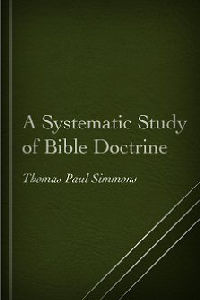The Holy New Covenant Translation was created by the Galilee Translation Project. A group of Christians translated the New Testament while in Palestine in 1975. It was distributed in the area of Palestine and used in many foreign schools to teach the English language. It was also translated into Arabic and distributed in the Middle East. The translation was again printed in 1999, and placed online and in the public domain in 2002.
The text can be located at http://www.thomhacke…ew-covenant.htm
See the above link for “The Enigma of Translation,” an example of the translation theory and explanation of how and why words are translated the way they are in this version. The document amply explains that concepts never change, but the words used to describe them do. The word “Love” is the example used in this document.

T.R. Simmons A Systematic Study of Bible Doctrine is a Bible Doctrines book of 43 chapters. The author is (according to the Introduction) "systematic, Calvinistic, Baptist, and premillennial". I am offering this work in various formats:
PDF: Simmons A Systematic Study of Bible Doctrine.pdf
Microsoft Word DOCX: Simmons A Systematic Study of Bible Doctrine.docx
OpenOffice ODT: Simmons A Systematic Study of Bible Doctrine.odt
EPUB: Simmons A Systematic Study of Bible Doctrine.epub
theWord: Simmons A Systematic Study of Bible Doctrine.twm
eSword: Simmons A Systematic Study of Bible Doctrine.topx
MySword: Simmons A Systematic Study of Bible Doctrine.mybible
1. Enigma of Translation
2. Love is More than a Word; it is a Concept
3. Concept-Clearing Center
4. One More Word Study
5. Love is an Action
6. A Workable Definition of Love that Jesus Commands
7. Agape
8. Works Referenced
Foreword by the Galilee Translation Project Team
Every new generation deserves a new translation of the Bible, for many words change in meaning as time moves on. Communication is a problem for all ages and all cultures, a problem for all peoples in all times. Certainly, the problem of communicating biblical truth is ever with us.
This becomes increasingly apparent in a century that has seen the good news of Jesus taken to all parts of the globe. Certainly, Bible translators have wrestled with the problem of whether to translate word for word the literal meaning of the earliest Bible texts into English, Japanese, Chinese, Arabic and other languages, or to attempt to translate the concept/idea expressed in the words. Many translators have taken a path that was religiously and politically safe — they transliterated certain words rather than translate the meaning. This is indeed true of words such as baptism, grace and love.
Another problem is choosing the word that most closely translates the original concept into the target language. In translating from a very precise language into a language that lacks the same precision of expression, there arises the problem of exactness in translation. There is a sense in which no translation is as exact as the original language. Jesus alludes to the problem of new commandments and old entrenched religious attitudes in speaking of new wine and old wineskins — both will be lost or destroyed should new wine be put into old wineskins. Hence, many translators have chosen to preserve the old wineskins rather than accept the new wine. Sometimes man has chosen the safer path of using a word that is overworked or not as straightforward in meaning so as to prevent retaliation from established church dogma. Sometimes his own lack of understanding has prevented correct translation. This is why we have translated love, the love Jesus Christ commanded, as: “give yourself to others, for their good, expecting nothing in return.”
This translation of the New Covenant is an attempt by its translators to define one of the most important words in any language. Undoubtedly, the attempt will fall short in some aspects — language is not as precise as mathematics. But because of the weight of the doctrine connected with this translation problem, we must attempt to understand the Lord’s meaning when He commanded us to love. Many things that one must do or say for the first time seem awkward or clumsy. However, the more we practice or repeat them, the more natural they become. All translations have the message of God, so why create another translation? To make it easier to meet needs of present young people and others to discover for themselves the unique words. We realize how feeble are all of our attempts, especially in our own language, to communicate biblical truth to others. For this attempt to communicate the greatest of all commandments to men is the most important thing that we can do. And we must communicate it in such a way that the listener or reader can put into action that which the Lord has commanded. May God bless you as you read this New Covenant, and may He give you strength to carry out His commandment, once you have understood it.
This content is not copyrighted and may be freely distributed.
Please credit the Galilee Translation Project.
Download
Holy-New-Covenant.nt (41 downloads )More from this Category
- Brenton’s English Septuagint (Brenton) (1851)
- American King James Version AKJV (1999)
- American Bible Union New Testament 1865
- Accurate New Testament ANT+
- The Living Bible
- The Timeless King James Update (TKJU) New Testament
- ExeGeses Ready Research Bible ERRB
- Easy to Read Bible ERV
- Restored Holy Bible Poetic Layout
- Updated KJV Bible
Advertisement
Are you looking for a Bible program/utility to watch your clipboard and detect Bible verse references? theWord can be configured to automatically popup a Window with the full verse reference(s) by just selecting and control-C copying the reference into your clipboard, and boom, a tiny window pops up with the reference. Additionally you can press a keystroke combination and change that reference into that full verse(s). videos on how to do this included on this page.
